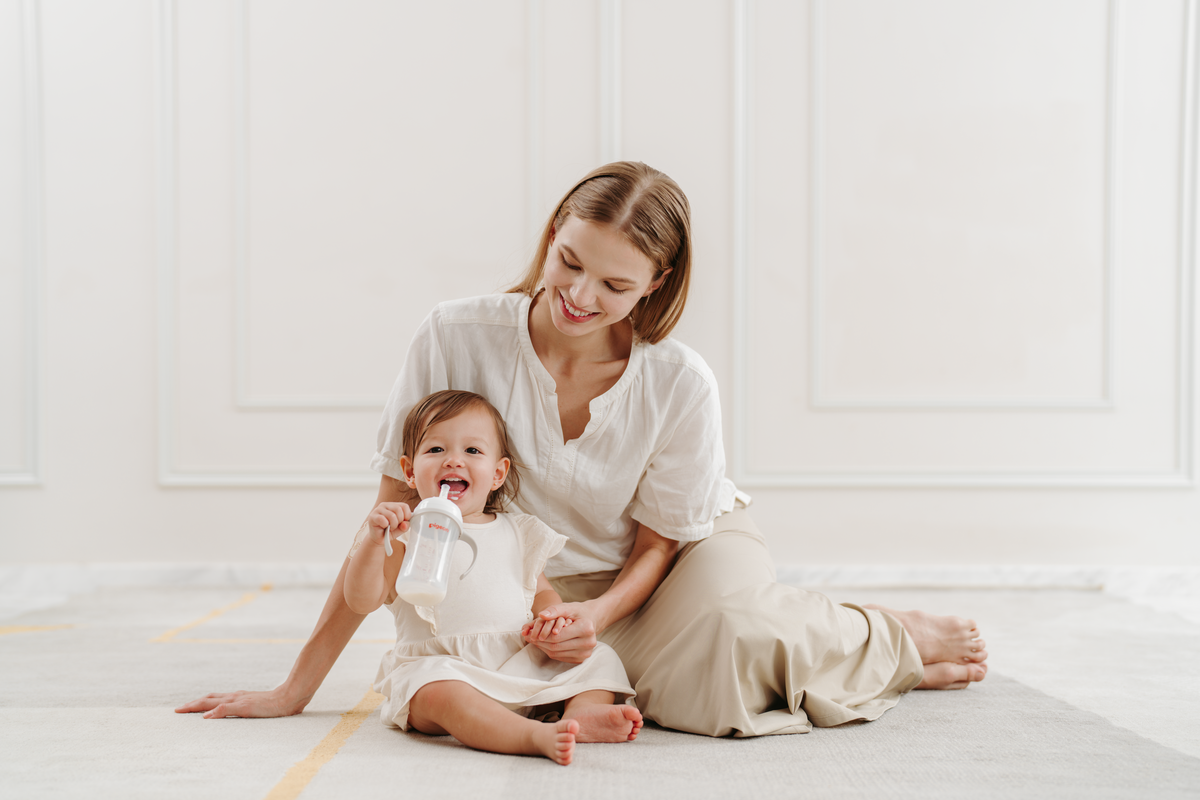Recent Articles
-
Is Your Baby’s Cup Helping or Hindering Their Oral Development?
Learn from Speech & Feeding Therapist Dr Lisa Lim how straw drinking supports your baby’s oral development, and why the Pigeon StarTouch™ Cup makes the difference. -
MiniLight Pacifiers Made with Purpose Initiative
Discover the Pigeon MiniLight Pacifier, ultra-light, baby-safe, and designed with purpose through The Animal Project collaboration for comfort and inclusion. -
SofTouch vs. Step-Up: Which Pigeon Bottle Fits Your Baby’s Stage?
Discover the difference between Pigeon SofTouch™ and Step-Up™ bottles — two feeding systems designed to support your baby from first latch to independent sipping.
Baby Feeding Milestones: What to Expect in the First 18 Months

Feeding Is a Journey, Not a Race
Here at Pigeon, we understand how overwhelming it can feel navigating bottles, purees, and sippy cups—especially in those early months. That’s why we’ve created this guide to help you understand your baby’s feeding milestones and feel confident supporting them at every stage. Every baby has their own rhythm, and feeding isn’t about ticking boxes but making each stage a little smoother for both of you.
0–6 Months: Breastfeeding or Bottle Feeding
In the early months, your baby’s feeding routine revolves around breastmilk or formula. Newborns typically feed 8–12 times in 24 hours.
If you’re introducing bottle-feeding, look for bottles designed to support a natural latch and reduce colic.
Product Tip: Pigeon’s SofTouch™ bottles are designed to mimic breastfeeding and help babies transition seamlessly between breast and bottle. Read more about our air-vented teat technology.
Signs your baby is feeding well include steady weight gain and 5–6 wet nappies per day.

6–9 Months: Introducing Solids
At around six months, your baby is ready for solids.
Signs Your Baby Is Ready for Solids
- Can sit up unassisted (shows their stomach, spine, and body are strong enough to digest food)
- Shows interest in food and watches others eat
- Has good head and neck control
- Opens mouth when offered a spoon
- Loss of tongue-thrust reflex (less likely to push food out of their mouth)
Start with smooth purees and gradually add soft finger foods.
- Offer solids once a day, then increase to 2–3 times as they adjust.
- Breastmilk or formula remains the main source of nutrition.
- Encourage baby to drink small amounts of cooled, boiled water in a training cup to develop cup-feeding skills.

9–12 Months: Learning to Self-Feed
Your baby is now ready for more textures and practicing self-feeding. This is a great time to encourage them to hold a spoon and start using a straw or sippy cup.
Product Tip: Step-Up Straw Bottle supports this transition with an ergonomic design and spill-proof straw, perfect for developing independence.
- Gradually reduce bottle feeds and replace them with snacks or cup feeds.
- Offer water in a straw bottle during mealtimes to build the habit.
12–18 Months: Weaning from the Bottle
By 12 months, most babies are ready to start weaning from bottles. Encourage using cups for milk and water and reduce bottles to only bedtime if needed.
- Start by replacing one bottle feed at a time with a snack or cup feed.
- Offer plenty of encouragement as your baby learns this new skill.
Product Tip: Pigeon’s Step-Up range makes this transition smoother with baby-friendly, spill-proof designs.
According to official guidelines, it’s recommended to stop bottle feeding by 18 months to support healthy oral development. Read more about the Signs Your Baby is Ready to Transition to help support your bubs journey.

Feeding transitions can be messy, and that’s okay. Babies often need time to adjust to new textures, cups, and routines.
Be patient and keep offering gentle encouragement. With consistency, you’ll both find your rhythm.
Baby Feeding Questions & Answers for Parents
Q: What bottles are best for breastfed babies who refuse other bottles?
A: Look for bottles with a soft, flexible nipple that mimics breastfeeding. Pigeon SofTouch™ bottles are designed for seamless breast-to-bottle transitions and can help reduce nipple confusion.
Q: When should I introduce solids to my baby?
A: Most babies are ready to start solids around 6 months, but watch for signs like good head control, interest in food, and ability to sit with support.
Q: How do I transition my baby from bottle to sippy cup?
A: Start by offering a sippy or straw cup with water at mealtimes around 6–9 months. Gradually replace one bottle feed at a time with a cup feed.
Q: Why should I stop bottle feeding by 18 months?
A: Prolonged bottle use can impact oral health and make weaning harder later. Experts recommend transitioning to cups by 18 months to support healthy development.





